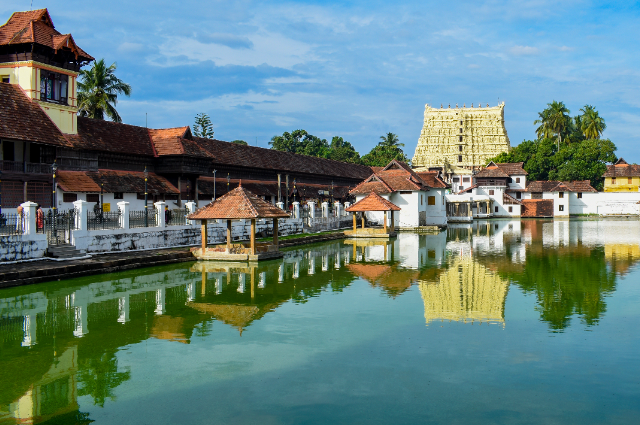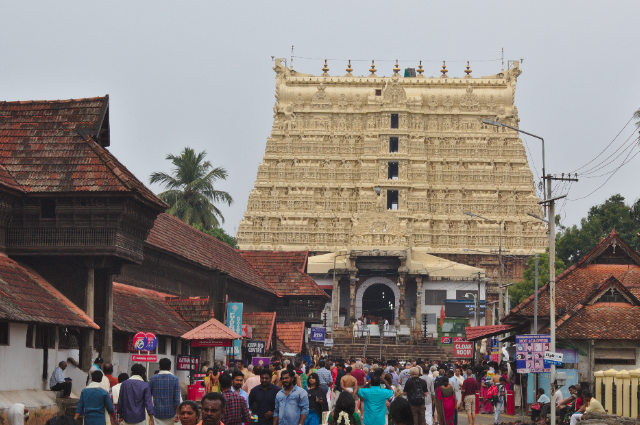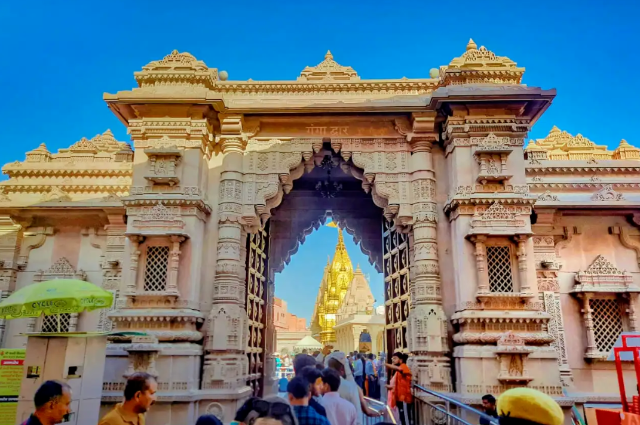At the heart of Kerala, one finds the Padmanabhaswamy Temple, a site of breathtaking architecture, old tradition, and vaults so overflowing with treasure that they make Indiana Jones films look realistic. Thousands of kilometers distant, the Kashi Vishwanath Temple in Varanasi is abuzz with brand-new infrastructure, crowd management strategies, riverfront illumination, and selfie points. What on earth is going on here?
India, the land of saints, scriptures, and gods, has long been a spiritual nation. But over the past decade, an interesting thing has been occurring. Temples are no longer simply spiritual pilgrimages; now they're becoming tourist destinations in their own right. From helicopter tours to skip-the-line tickets, temple pilgrimages are being transformed by development, digitalization, and, okay, money. Are we headed into an age when temples are becoming India's equivalent of theme parks, devout, sure, but also commercial, staged, and sort of Instagrammable? Let’s explore what this rise in temple tourism means for pilgrims, local economies, and critics who warn of “spiritual consumerism.” And to really understand what’s happening, we’ll take a close look at two iconic temples: Padmanabhaswamy Temple in Kerala and Kashi Vishwanath Temple in Uttar Pradesh.
Not Just Prayers Anymore
First, let's define what by "temple tourism." It's not new, of course. Human beings have been going to temples for thousands of years. Whether it was the Char Dham Yatra, Vaishno Devi, or Tirupati, temple-based travel has been a part of Indian life. But the scale, style, and structure of this tourism have transformed with a vengeance. Here's how:
- Big-budget temple corridors are being constructed (such as in Ayodhya, Ujjain, and Varanasi).
- Temple complexes now have cafes, shopping, digital museums, and mobile apps.
- Helicopter services and charter flights are being provided to far-flung temples.
- Luxury stays and spiritual tour packages are being promoted aggressively.
Religion is getting a facelift, and it has a marketing department.
Padmanabhaswamy Temple – Where Devotion Meets Mystery
Situated in Thiruvananthapuram, Kerala's capital, the Padmanabhaswamy Temple is not only a faith centre, but it's a gold-wrapped enigma.
The Treasure Trove
In 2011, a Supreme Court-ordered inventory uncovered something stunning: Treasures in the temple vaults amounted to over Rs. 1 lakh crore. Gold coins, diamond necklaces, antique idols, it was like discovering a royal bank beneath a shrine. This find put the temple on the global map. Suddenly, it was no longer a place of worship; it was a shrine of untold riches, ancient history, and mystery.
Tourists
Before long, tourists began arriving. Not only pilgrims, but history enthusiasts, curious backpackers, and Instagram tourists. Hotels in the vicinity of the temple noticed an increase in bookings. Local guides started conducting "treasure walks." Merchants in the area doubled their souvenir offerings. But here's the twist: Non-Hindus can't enter the temple. No photos are permitted. So most visitors stand in the parking lot, snap a couple of pictures of the imposing gopuram, and listen to stories about Vault B, one that has not yet been opened and is said to be cursed. Nevertheless, that has not prevented the economy surrounding the temple from flourishing. From tea vendors to travel agencies, everybody is cashing in.
Kashi Vishwanath – The Corridor That Changed Everything
Now, let's visit Varanasi, the spiritual hub of India. There stands the Kashi Vishwanath Temple, a temple for Lord Shiva. The ancient temple, one of the twelve jyotirlingas, was always a prominent pilgrimage site. But when the Kashi Vishwanath Corridor project was initiated in 2021, things changed altogether.
What's the Corridor?
Picture clean, broad pathways. Humongous stone walls. Fountains. Light displays. An open, unobstructed path from the temple to the Ganga. That's the Corridor. It took more than Rs. 800 crore and more than 300 homes and buildings (some being ancient temples) to be relocated or destroyed. For what? To make the area more accessible, organized, and visually appealing.
Tourism Explosion
The outcome? Five times as many visitors. Travelers from across the globe throng the temple not only to seek blessings but to sample the new arrangement. The ghats are cleaner, the temple is less crowded, and the infrastructure is traveler-friendly. There are digital guides in the form of QR codes. Battery-powered carts for the elderly. River-adjacent viewing decks. Cafeterias with vegetarian fusion cuisine. And naturally, numerous stalls offering Kashi-themed souvenirs. It's sort of a religious Disneyland with lots more incense.
The Pros: Why Temple Tourism is Booming
So why is this occurring? Why are temples the new tourist spots? Here's what's fueling the shift:
1. Economic Growth
Temples attract people. People attract money. That's the arithmetic. Hotels, restaurants, local merchants, taxis, and guides all gain when more tourists come by. Government estimates say that cities like Varanasi, Ayodhya, and Tirupati generate hundreds of crores each year from tourism spending. In a few small towns, temple tourism is the principal means of livelihood for thousands.
2. Improved Infrastructure
Let's not kid ourselves: most pilgrimage destinations were once messy and unclean. Crowds, endless lines, and bad sanitation, it wasn't exactly a nice religious experience. The new temple proposals are transforming that. Sanitized corridors, systematized darshan schemes, mobile apps, digital maps, and security features make the experience easier for pilgrims and tourists.
3. Cultural Revival
With renewed focus on temple heritage, ancient art and architecture are being restored. Temples that were crumbling are being rebuilt. Cultural programs, music festivals, and educational exhibits are reviving interest in India’s religious past.
The Cons: When Worship Meets Wallet
Of course, not everyone is happy. Critics argue that we’re losing something sacred in all this development.
1. Spiritual Consumerism
Most think religion is getting too commercialized. When a temple turns into a selfie spot, or when a VIP darshan costs more than a concert ticket, is it more about devotion or convenience? "Spiritual consumerism" is a phrase being increasingly uttered today, explaining how religion is being wrapped up, marketed, and consumed like a commodity.
2. Displacement and Erasure
In other instances, redevelopment has involved knocking down the old houses, stores, and even heritage buildings. Hundreds were displaced in Varanasi for the corridor project. Not all were paid justly. Some contend that the "old charm" of a narrow street and small shrines was lost forever.
3. Unequal Access
Whereas temples such as Padmanabhaswamy have religious access restrictions, others provide "VIP passes" for quicker entry. Questions arise about whether spirituality should be paid for or religiously restricted. Let's not fool ourselves, temple tourism these days is a mixed bag. It's half pilgrimage, half holiday, half culture excursion. You may go for spiritual calm, but you'll probably return home with a trinket, a couple of snaps, and perhaps a dosa from the temple canteen.
Temple tourism these days often includes:
- Timed darshan bookings
- Augmented reality temple guides
- Laser light shows at night
- VIP lounges for donors
Does that reduce their sacredness? Or make them more contemporary? Depends on whom you ask.
For an 80-year-old pilgrim who is now able to access a jyotirlinga without being pushed around, it's a blessing. For a traditional devotee who laments the end of quiet chanting and candle-lit passageways, it could be too much glitter.
The Way Forward: Can Devotion and Development Coexist?
The good news is, they can. The problem is balance!!
- Respect heritage while constructing infrastructure.
- Involve local communities in development plans.
- Provide access without making devotion commercial.
- Maintain the spirit, not the crowds.
There are already temples that are setting the example. The Meenakshi Temple in Madurai maintained its artistic integrity while handling huge numbers with ease. The Golden Temple in Amritsar feeds thousands daily, free of cost, proving that spiritual service can remain at the core of temple life.
Religion During Tourism
Temples have never been merely sites of worship. They're community centers, history books, schools of spirituality, and economic drivers. In a transforming India where religion collides with modernity at every step, temple tourism is just the next chapter in an ancient tradition. Whether you're lighting a lamp in reverent silence or taking a photo alongside a freshly buffed pillar, you're part of something greater, India's unfolding spiritual narrative. So yes, temples are holy. And yes, they're getting commercialized too. But perhaps, just perhaps, they can be both.



